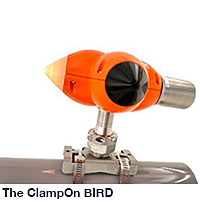ClampOn BIRD flies in
25/08/2022
The ClampOn BIRD is a new and unique wireless acoustic sensor for the downstream, unconventional and renewable energy market. The battery-operated intelligent remote detector (BIRD) is a non-intrusive instrument that can be used for various types of condition monitoring on pipes, flowlines, valves and structures.
The BIRD can provide an early warning of potential weaknesses of pipes and structures, providing the operator with information that will assist with making decisions for their asset to meet their individual decarbonisation goals.
With wireless communication and power from an internal battery, the need for expensive cabling, complex wiring diagrams and termination boxes is now a thing of the past.
By measuring, analysing and reporting acoustic noise, temperature and vibration, the BIRD is extremely flexible and can be used for leak monitoring, vibration detection, steam detection, foam monitoring, temperature monitoring, process monitoring, particle monitoring and pig detection.
The ClampOn BIRD offers the latest technology, including energy efficient digital signal processing, a very-low-power radio-frequency node and a sub 1 GHz programmable ultra-low-power mode. These technologies combine to allow the sensor to operate for more than a year on a single power module (internal battery). The ClampOn BIRD sensor continuously monitors the condition of the power module and will inform the client when replacement is due.
The BIRD has a wireless range of up to 1000 m (line of sight) and its multi-function capability is designed and approved for worldwide operation in just about any industry.
The sensors are supplied fully calibrated, without the need for on-site calibration, and can be easily clamped to any pipe. With its wireless connection interface, the ClampOn BIRD sensor creates a self-forming mesh network that will add any additional ClampOn BIRD sensor to the network automatically. Setting up a network of ClampOn BIRD sensors only takes a few hours. Even installations in remote and rural locations are no longer a problem.